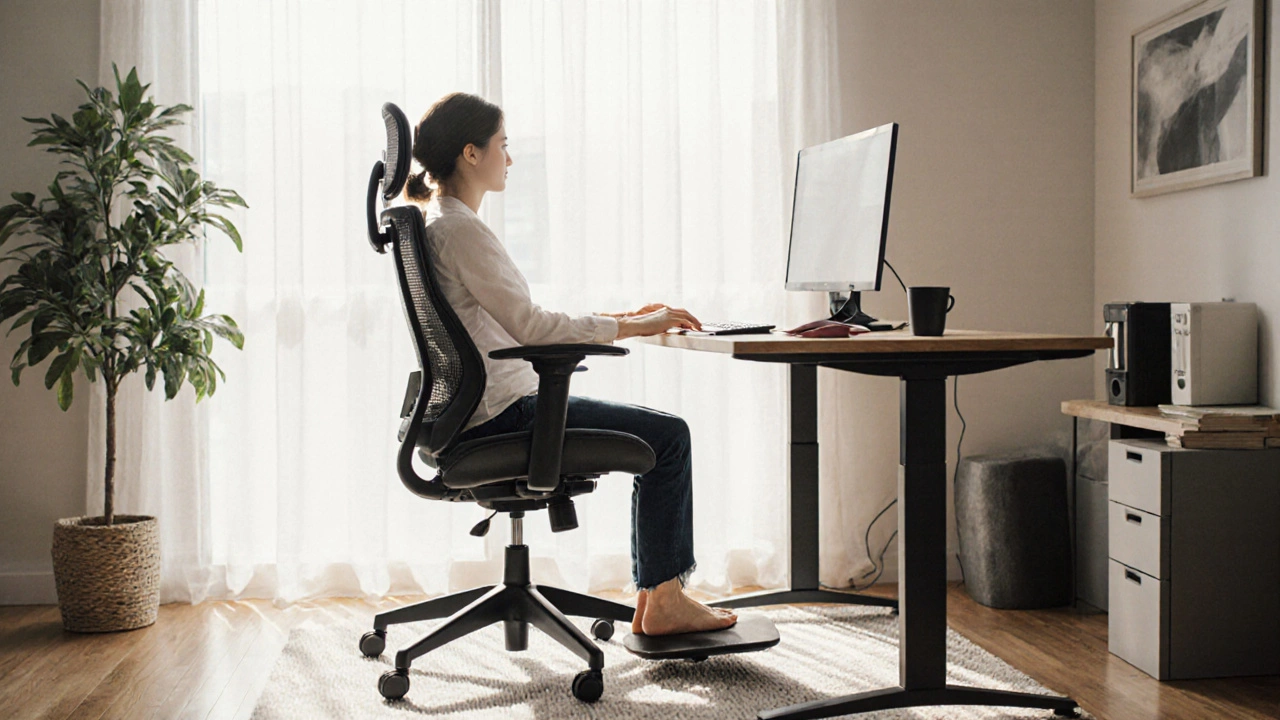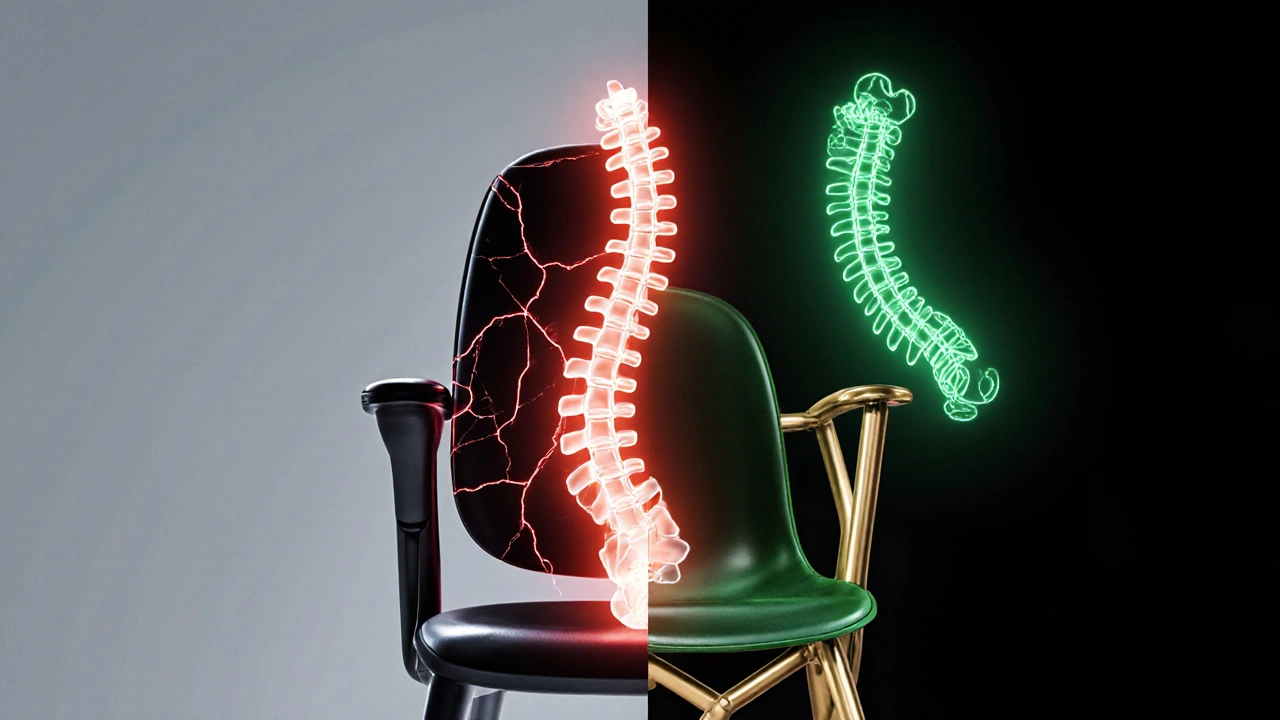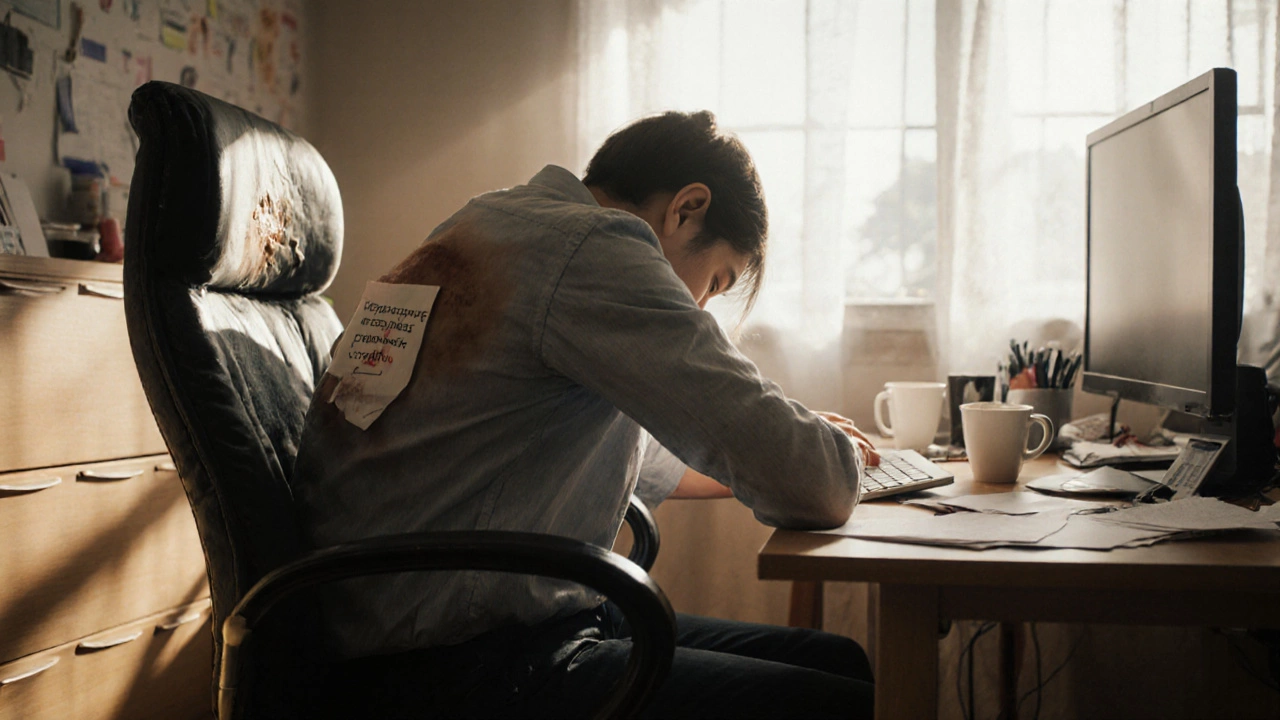Spending too little on a desk chair can cost you more in the long run-back pain, lost productivity, even medical bills. Spending too much? You might just end up with a fancy seat you never really use. So how much should you actually spend on a good desk chair? The answer isn’t a number. It’s a balance between your body, your work habits, and your budget.
Why a cheap chair is a false economy
You see them everywhere: $50 office chairs from big-box stores. They look fine at first. Maybe they even have a little lumbar support sticker on the back. But after three months, the foam flattens. The armrests wobble. The gas lift starts sinking slowly, like your posture. By six months, you’re leaning forward, shoulders hunched, neck tight. That’s not just uncomfortable-it’s damaging.A 2024 study from the University of Leeds’ Human Factors Lab tracked 120 remote workers over six months. Those using chairs under $100 reported a 68% increase in lower back discomfort. Those using chairs over $200? Only 19%. The difference wasn’t just comfort. It was daily function. People with better chairs took fewer breaks. They stayed focused longer. Their productivity didn’t drop.
Think of it like shoes. You wouldn’t run a marathon in $20 sneakers. Why sit for 8 hours a day in a $70 chair?
What makes a good desk chair? Break it down
Not all chairs labeled "ergonomic" are created equal. Here’s what actually matters:- Adjustable lumbar support-not just a fixed bump. It should move up and down and adjust depth to fit your spine’s natural curve.
- Seat depth adjustment-your thighs should have 1-2 inches of space between the edge of the seat and the back of your knees.
- Armrests that move in four directions-up/down, in/out, forward/back, and pivot. If they’re fixed, they’ll force your shoulders into tension.
- High-quality casters-hard floor casters for tile or wood, soft for carpet. Cheap ones jam or scratch floors.
- Breathable mesh back-polyester or nylon mesh keeps you cooler than vinyl or foam. You’ll sweat less. You’ll sit longer.
These features aren’t luxury. They’re basics. If a chair doesn’t have them, it’s not ergonomic-it’s decorative.
Price brackets: What you get at each level
| Price Range | What’s Included | Who It’s For | Expected Lifespan |
|---|---|---|---|
| $50-$100 | Basic plastic frame, fixed backrest, foam cushion that flattens fast, no armrest adjustment | Occasional users, students, short-term rentals | 6-12 months |
| $120-$200 | Adjustable lumbar, seat depth, 2-way armrests, mesh back, decent casters | Remote workers, hybrid employees, 4-6 hours/day | 3-5 years |
| $250-$400 | Full 4D armrests, synchronized tilt, headrest, premium mesh, weight capacity up to 300 lbs | Full-time remote workers, people with chronic pain, long workdays | 5-8 years |
| $450+ | Customizable contours, memory foam seat, advanced tilt mechanics, manufacturer warranty up to 12 years | Professionals who sit 8+ hours daily, therapists, designers, executives | 8-15 years |
Most people don’t need a $500 chair. But $150 is the new floor. If you’re working from home more than 3 days a week, anything under $120 is a gamble.

Where to buy and what to avoid
Stick to brands with real track records: Herman Miller a premium office chair brand known for its Aeron and Embody chairs, designed for long-term ergonomic support, Steelcase a leading manufacturer of office furniture with a focus on ergonomic design and durability for workplace environments, Secretlab a gaming and office chair brand offering high-quality, customizable seating with strong lumbar support and durable materials, and Autonomous a direct-to-consumer brand offering affordable ergonomic chairs with features typically found in higher-priced models.Avoid Amazon Basics, Walmart’s generic brands, and eBay listings with no reviews. These often copy designs but cut corners on materials. I’ve seen chairs from these brands collapse under 160 lbs. That’s not a fluke-it’s a design flaw.
Buy from retailers with free returns. You need to test the chair. Sit in it for a full day. Adjust it. Move around. If it feels wrong after 30 minutes, it will feel worse after 3 hours.
What to do if you can’t afford $200
Budget is real. Maybe you’re a student. Maybe you’re on a tight income. That doesn’t mean you have to suffer.- Look for last year’s model. Brands like Autonomous and Secretlab drop prices 20-30% when they release new versions.
- Check refurbished listings from Herman Miller or Steelcase. They’re certified, cleaned, and come with full warranties. You can get a nearly new Aeron for under $300.
- Use a lumbar cushion. A $25 memory foam one can fix a $70 chair’s biggest flaw. Pair it with a footrest and you’re 80% there.
- Set a savings goal. Put $20 a month aside. In 10 months, you’ve got a real chair. Your back will thank you.

It’s not about the chair-it’s about how you use it
Even the best chair won’t save you if you never move. No chair is a magic fix. You still need to:- Stand up every 30 minutes-even if just to stretch or grab water.
- Adjust your chair daily. Your posture changes. Your chair should too.
- Keep your screen at eye level. Slouching happens when you’re craning your neck.
- Use a footrest if your feet don’t touch the floor. Unsupported legs pull on your lower spine.
The chair is just the foundation. Movement, posture, and breaks are the real heroes.
Bottom line: What’s the right amount?
If you sit 5+ hours a day, spend $150-$250. That’s the sweet spot for most people. You get real adjustability, durable materials, and a chair that won’t break down before you’ve paid for it.If you sit 8+ hours a day, or you have existing back issues, spend $250-$400. This isn’t a luxury-it’s preventative healthcare.
If you’re on a tight budget, don’t buy the cheapest chair. Buy a good cushion, save up, and get a refurbished model. Your spine doesn’t care about your bank balance. It only cares if you’re supporting it properly.
Don’t treat your chair like a disposable item. It’s one of the most important tools you use every day. Spend wisely. Sit better. Work longer.
Is a $100 desk chair worth buying?
Only if you’re using it for less than an hour a day, or for a few months at most. For anything longer, it’s a trap. The materials degrade fast, support disappears, and you’ll end up paying more in discomfort and lost productivity than you saved upfront.
Do expensive chairs last longer?
Yes, significantly. Chairs under $150 typically last 1-2 years. Chairs in the $200-$400 range last 5-8 years on average. Premium models from Herman Miller or Steelcase come with 10-12 year warranties and are designed to be repaired, not replaced. That means you’re paying more upfront but less over time.
Can I use a gaming chair as an office chair?
Some can, but most can’t. Gaming chairs often have thick, non-breathable upholstery that traps heat. Their lumbar pillows are fixed and don’t adjust to your spine. They’re built for short bursts, not 8-hour days. Brands like Secretlab and Noblechairs make exceptions-they’ve improved their designs for long-term use. But avoid the cheap ones from unknown brands.
What’s the best office chair for back pain?
Look for chairs with fully adjustable lumbar support that lets you position the curve exactly where your lower back needs it. The Herman Miller Aeron, Steelcase Leap, and Autonomous ErgoChair Pro 2 are top choices. Pair it with a 2-inch memory foam lumbar cushion if your pain is severe. Also, make sure the seat depth lets your thighs rest fully without pressure behind the knees.
Should I buy a chair online or in person?
Always try to sit in one first. If you can’t, choose a retailer with free returns and a 30-day trial. Many brands like Autonomous and Secretlab offer this. Don’t buy based on photos or specs alone. The way a chair feels when you lean back, adjust the arms, or shift your weight is something you can’t guess.



